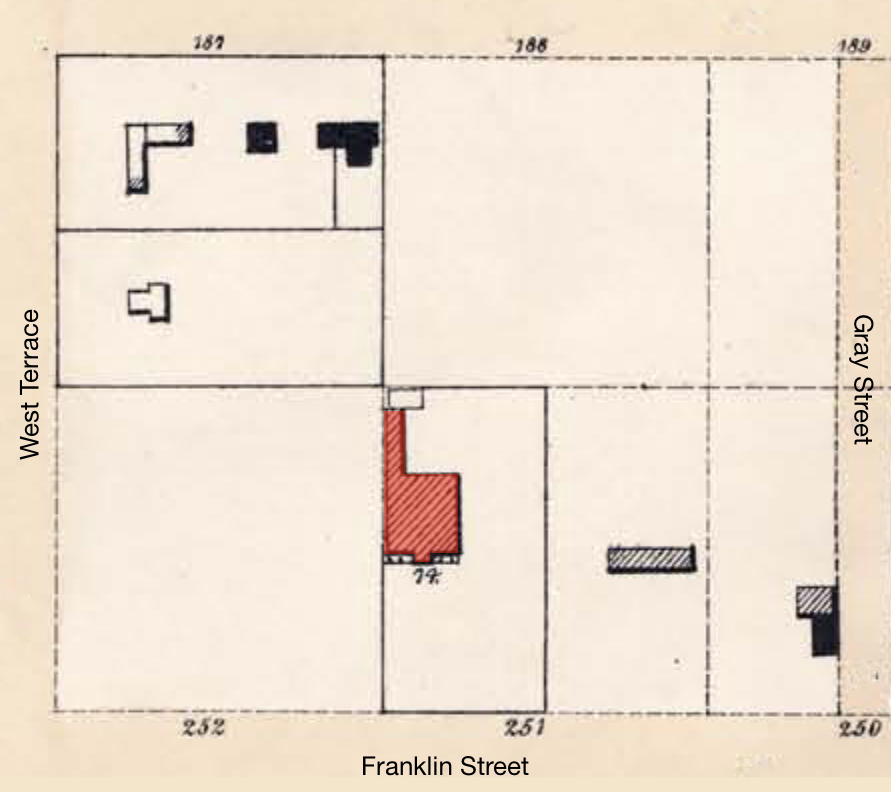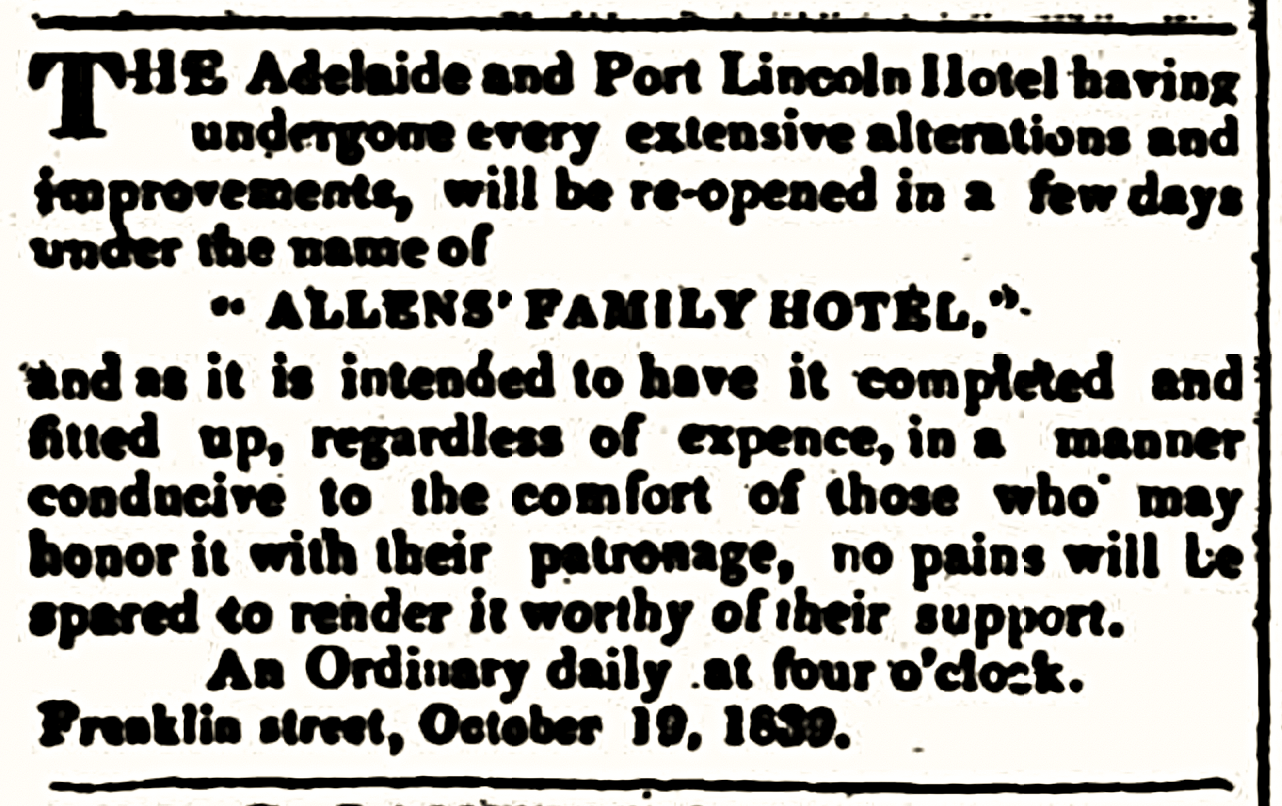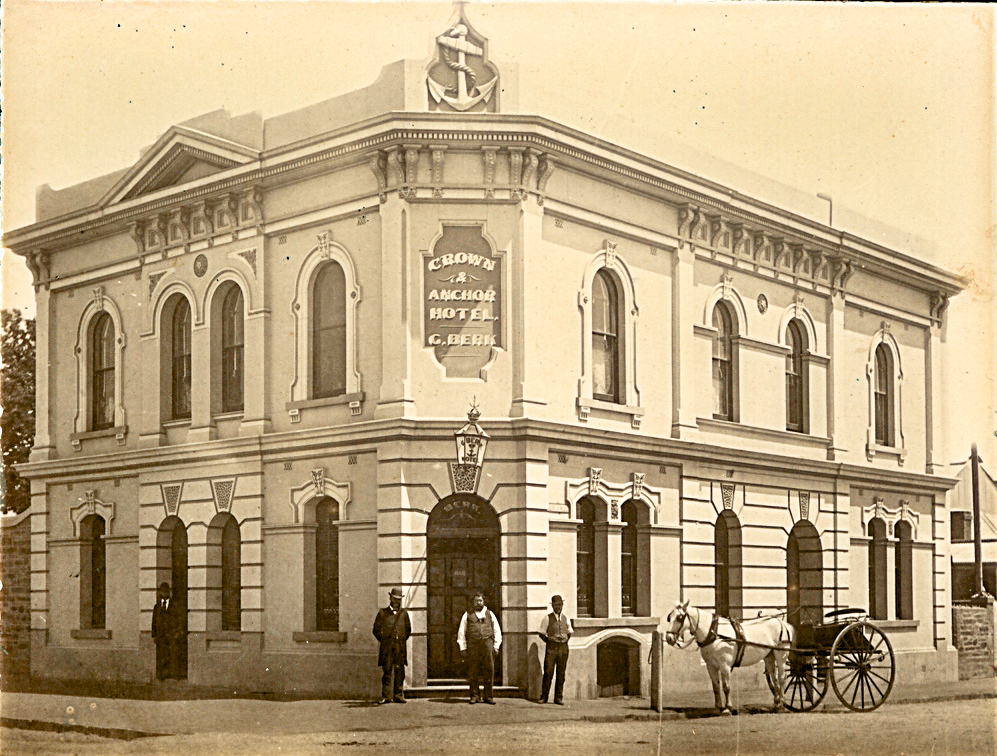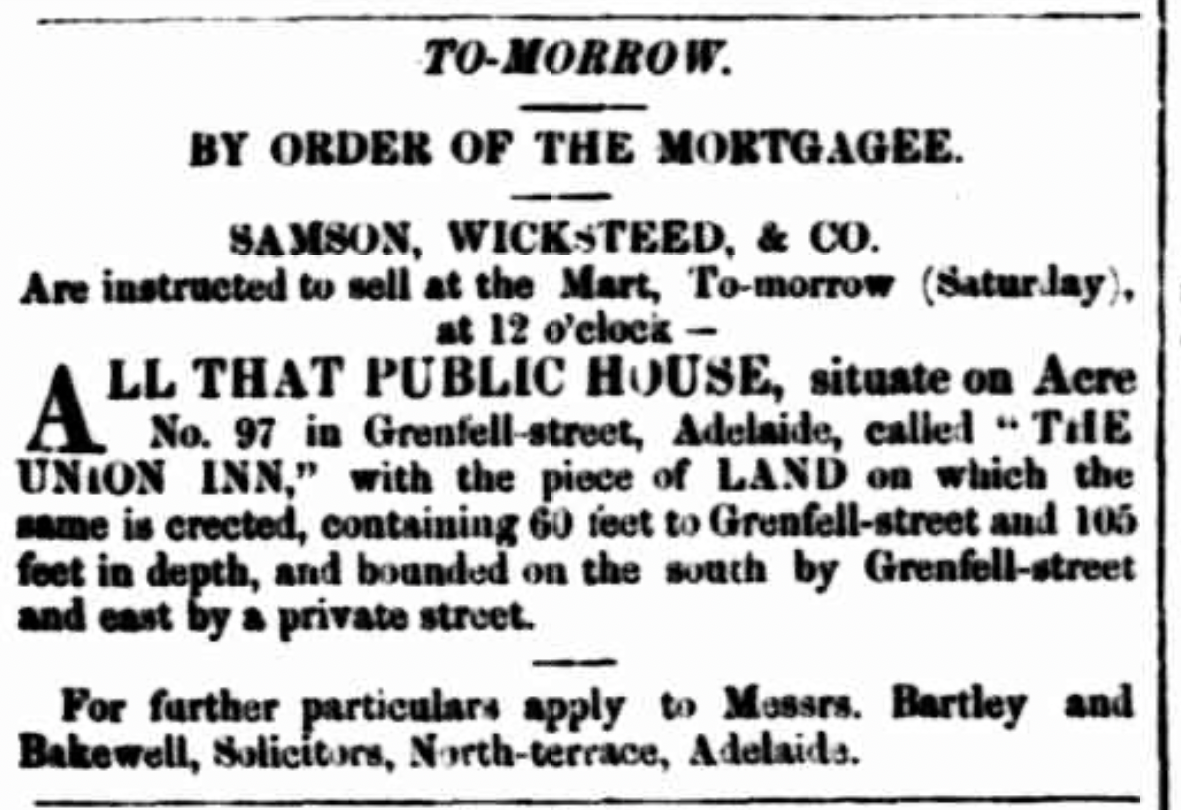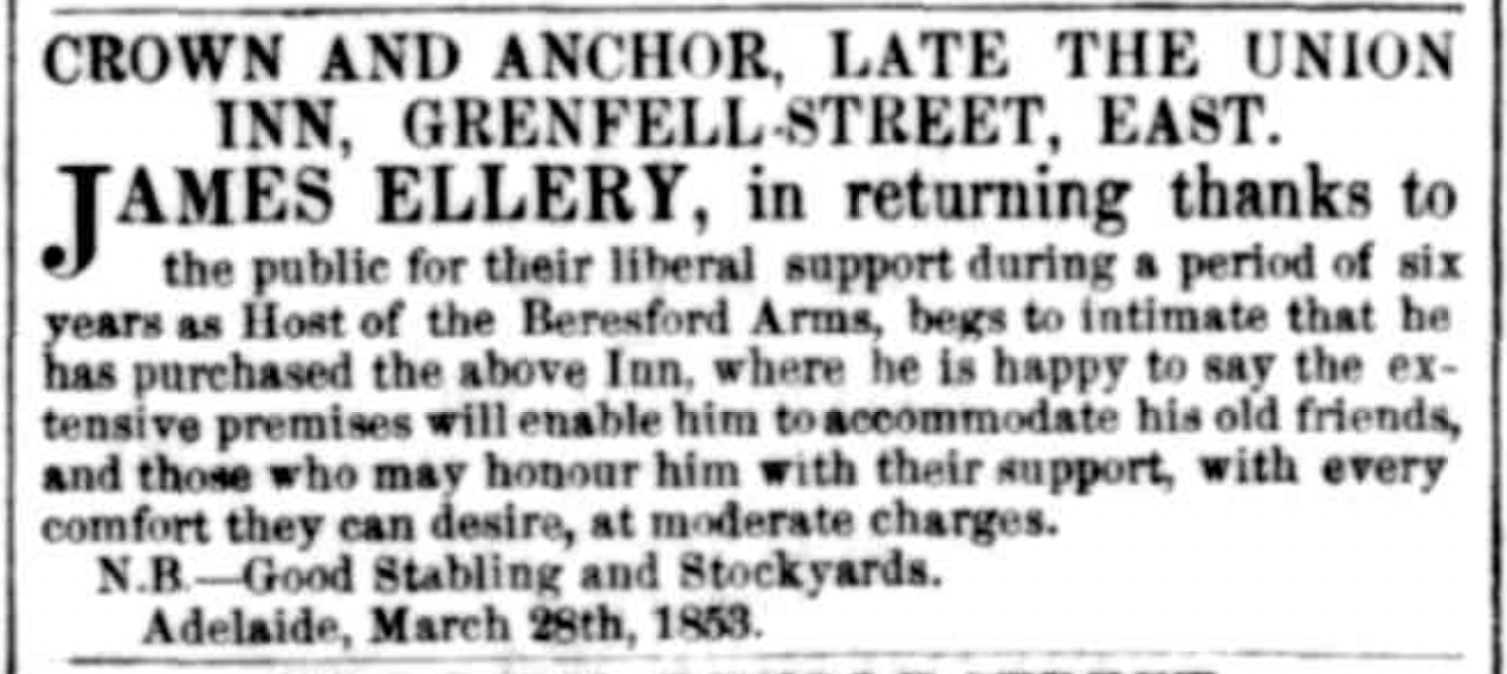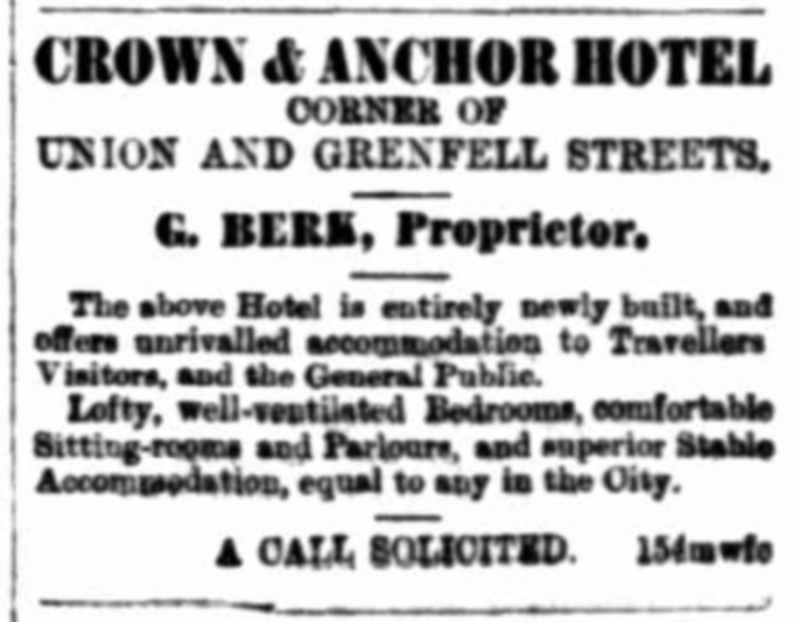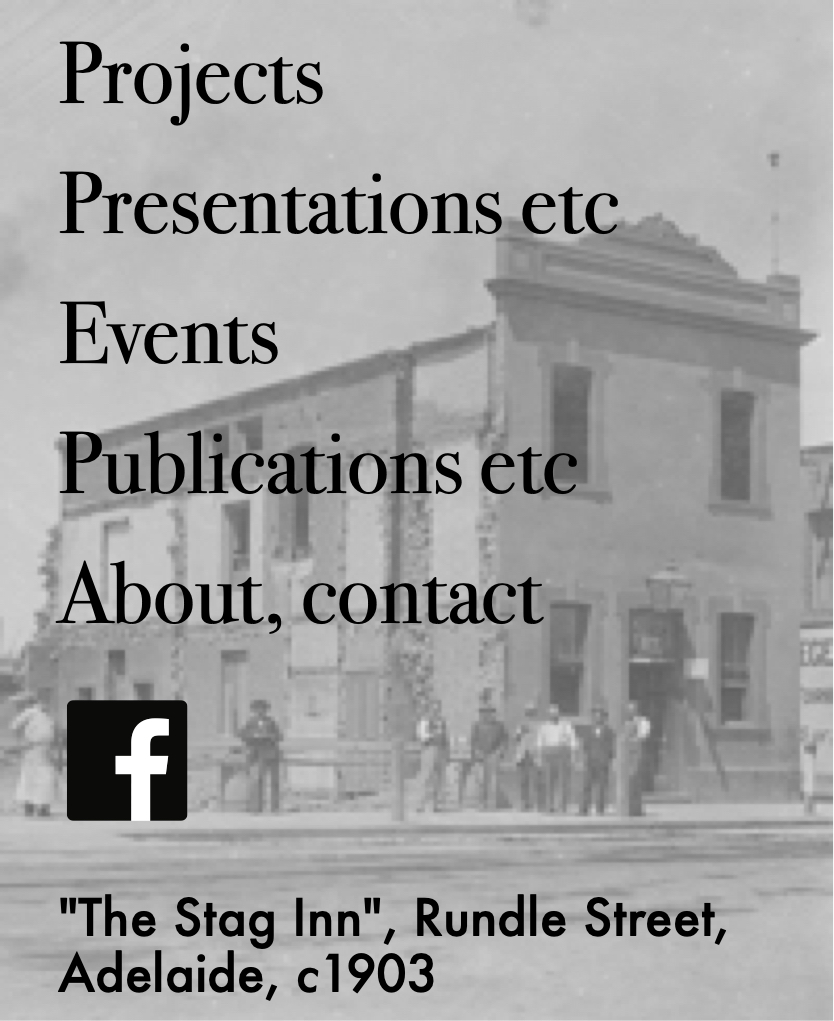
The what, when, who, how and why of the Kent Town Hotel
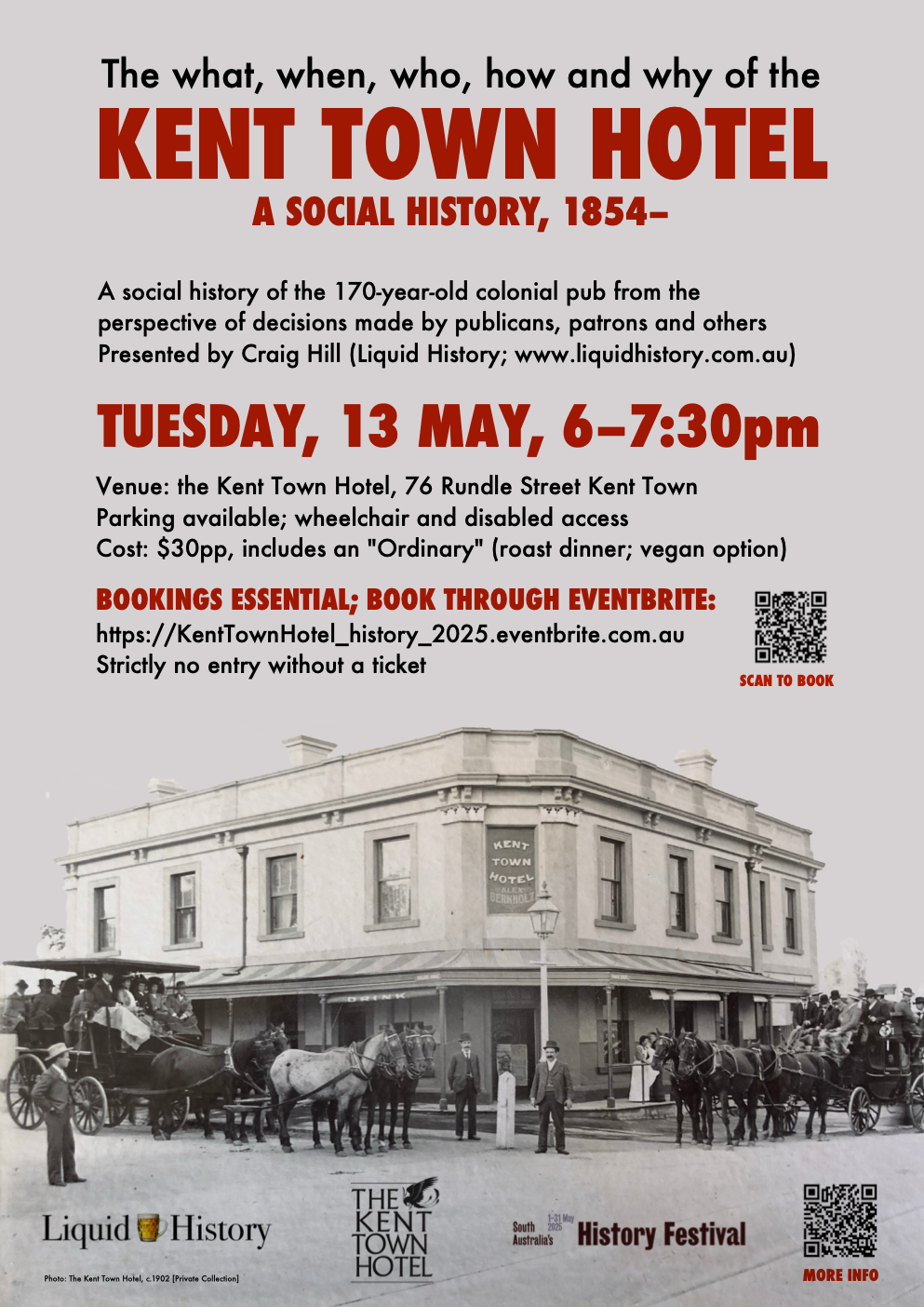 Click on the image to go to more information on the Kent Town Hotel Project
Click on the image to go to more information on the Kent Town Hotel Project
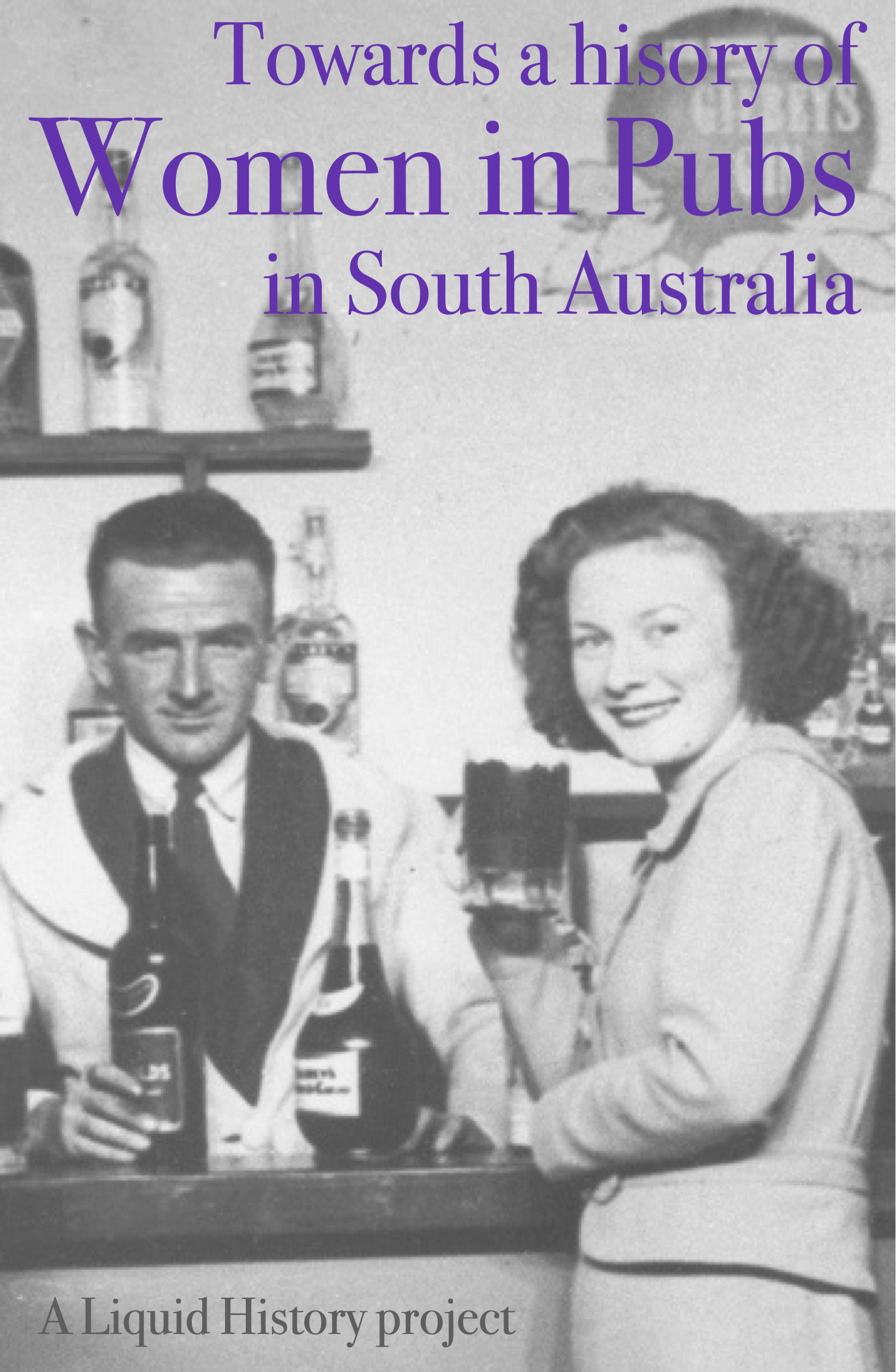 Click on the image to go to the Women in Pubs Project
Click on the image to go to the Women in Pubs Project
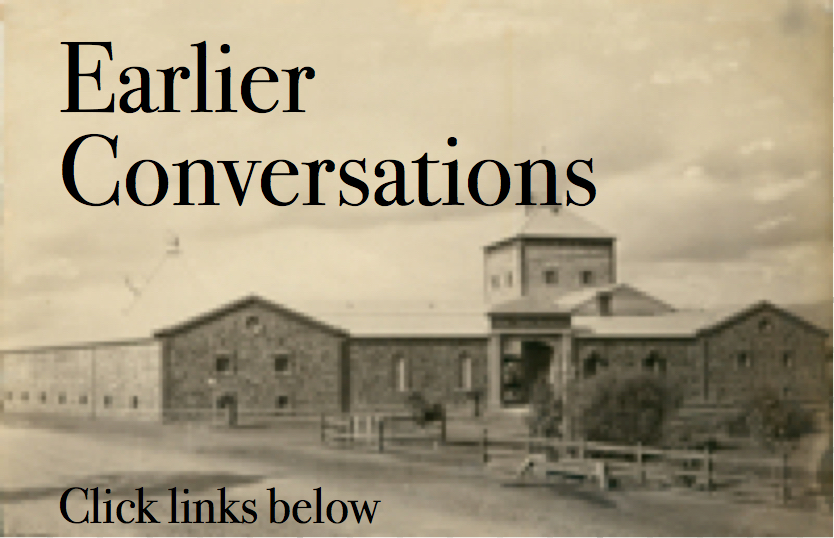
15 May 2023:
The origins of the Ship Inn, c.1839, at Encounter Bay
27 September 2022:
South Australian Working Men's Clubs
10 April 2022:
Clare Historic Pub-crawl
16 January 2022:
The East End Historic Pub-crawl; the winesaloons of the East End; and the York Hotel, Rundle Street East
30 November 2021:
Celebrating Saint Andrew's Day and early colonial South Australian pubs; and the Freemason's Tavern, Pirie Street
24 November 2021:
The Encounter Bay Historic Pub-crawl and a short note on the Middleton Hotel
17 May 2021:
Diwottiow pedrevanas: the Moonta Historic Pub-crawl and the Pier Hotel, Port Moonta
10 April & 1 May 2021:
Pubs of Port Adelaide and Knapman's Cannon Brewery, Port Adelaide
2 February 2021:
An historic pub crawl through Port Lincoln
4 January 2021:
The Kentish Arms Inn, Kent Town and Vintage Shades Tavern and the Buck's Head/Avenues Hotel
10 August &s 14 November 2020:
Finding the Fountain Inn (again)
10 August 2020:
One Fountain Inn or two?
20 June 2020:
Adding to the Colonist's story
1 May 2020:
The "Spanish 'Flu" and closing South Australian pubs, 1918-1920
25 September 2019:
Searching for C J Dennis' pubs in Adelaide
21 June 2019:
The Austral Hotel, 140 years old next year
29 March 2019:
Is the Edinburgh Castle South Australia's oldest licensed pub?
18 February 2019:
The Newmarket Hotel gravely ill and in need of a hospital?
10 August 2018
The Stag Inn - the beginning
2 August 2018:
To IPA or not to "I" the PA, or should that be an "A" question?
The East End Historical Pub-crawl:
Click the image below to download a self-guided walking tour of the East End pubs
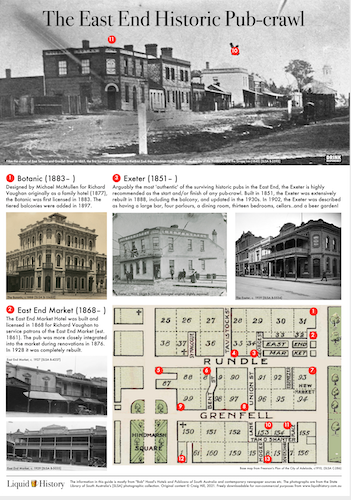
A small collection of legacy research papers, presentations or other resources related to the history of the South Australian olive industry that some might find interesting or useful...despite their age.
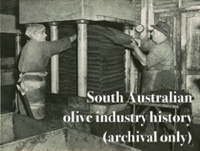

Worsening eyesight has now impacted my research especially current projects on women in pubs, the history of the Kent Town Hotel and the history of Logue's Brewery. For the immediate and medium future, posts will be even less frequent and shorter. Apologies for any inconvenience.
|
Correction: The first female licensee in South Australia?
Further research has revealed that, contrary to what I wrote on the Women in Pubs page, the first woman to be granted a general publican's license, whether in her own right or otherwise, was Amelia Allen.

Official transfer of Barnett's licence for the Adelaide and Port Lincoln Hotel to Amelia Allen (highlighted), 18 December 1839 [SA Gazette, 18 December 1839, p.2] Click on image to enlarge. [Coming soonish: more on Amelia Allen, the Allen family, the ill-fated sailing ship the Tam O'Shanter, passengers on South Australia's 'First Fleet' more generally and connections with early hotels/public houses.] Posted 16 November 2024 |
Heritage listing of South Australian pubs
The current controversy over the Crown and Anchor pub in Adelaide's East End and related issues around "cultural heritage" and "ownership" has prompted me to investigate which South Australian pubs have what type of heritage "protection". This is summarised in the table below; the original data is from the State Heritage Places Database as of 8 May 2024. (Apologies again for any errors - I'm still having problems with pivot tables.)
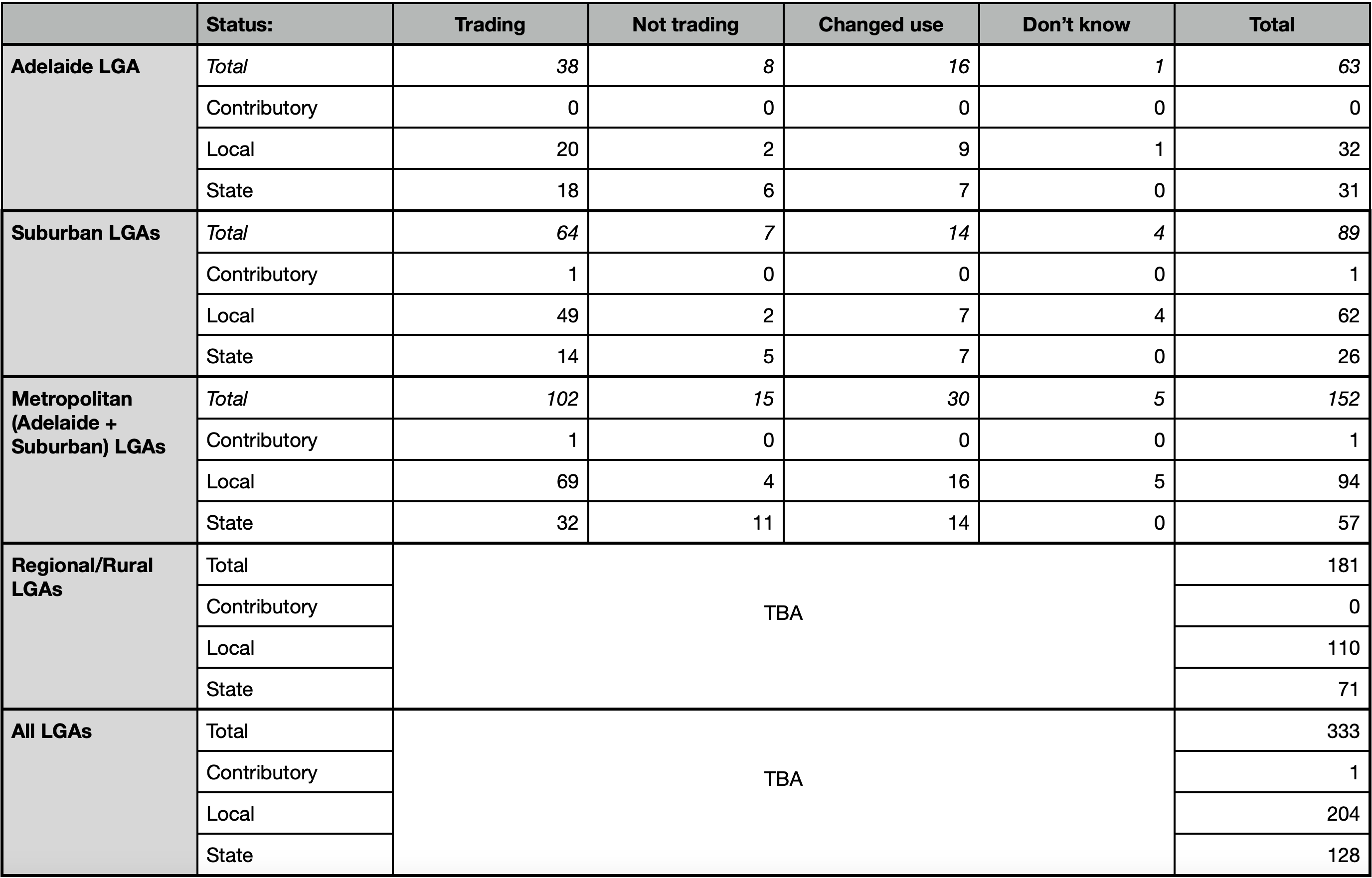
Adelaide and suburban pubs, by heritage class and status, May 2024 (Click to enlarge)
According to this data, 333 South Australian pubs have some level of heritage "protection", 204 (61%) at the "Local" level and 128 (38%) at the "State" level (in many cases by inclusion within the "State Heritage Area" classification). It has not been possible to identify which, if any, of the regional/rural pubs are currently not trading or are subject to development plans. However, of the 152 heritage listed pubs in Metropolitan Local Government Areas (Adelaide plus Suburban LGAs), 94 (62%) enjoy "Local" and 57 (37%) "State" listing; of these 14 metropolitan pubs are not trading (personal visit, active website or recent Facebook posts), appear to be more or less permanently closed and are, arguably, the most at risk of redevelopment similar to that threatening the Crown and Anchor.
These pubs are:
Local listing:
Edinburgh Castle, Adelaide
Old Queens Arms/Wright Hotel, Adelaide
[Former] Globe Hotel, Port Adelaide (already under redevelopment)
Jolly Miller Hotel, Hindmarsh
State listing:
Colonel Light Hotel, Adelaide
Hampshire Hotel, Adelaide
King's Head Hotel, Adelaide
Newmarket Hotel, Adelaide (recently threatened with redevelopment)
Oxford Hotel, [North] Adelaide
Producers Hotel, Adelaide
[Former] Britannia Hotel, Port Adelaide (recently redeveloped)
Port Dock Brewery Hotel, Port Adelaide
Railway Hotel, Port Adelaide
Royal Hotel, Kent Town (recently threatened with redevelopment)
Squatters Arms Hotel, Thebarton
Attached is the complete list of "Heritage listed" Adelaide and suburban pubs, by class of heritage listing (contributory, local or state) and, as far as I have been able to determine, current status (trading, not trading, change of use, don't know); those probably most at risk are in red.
Interestingly, like the Crown and Anchor, several of these have been music venues in the recent past (Edinburgh Castle, Railway, intermittently Producers, arguably the Newmarket).
[Posted originally 14 May 2024, updated 27 May. Original content © Craig Hill 2024]
|
Since posting the piece below I have come across Hosking Willis Architecture's Heritage Assessment of the Crown and Anchor Hotel, part of a second nomination for State Heritage listing of the pub (accessed 28 May; hopefully the report will remain available). This is a very well researched and produced document; I recommend it to anyone interested in the Crown and Anchor or pub (architecture) history in general. [Posted 29 May 2024] |
(Re-)development of The Union Inn/Crown and Anchor in the nineteenth century
The site, town acre 97, was mortgaged in early 1842 from Jacob Warn to John Yabsley Wakeham, at the time described as "carpenter, builder and undertaker", evidently to subdivide, erect buildings and sell them before the mortgage expired or before he could purchase the property [LSG Memorial 66/2]. Like many colonial builders - several of my own ancestors included - Wakeham was effectively a 'developer'. He was also an inaugural Adelaide City Councillor, serving from October 1840 to at least 1845.
|
As early as January 1842 Wakeham advertised the sale of "an excellent brick house containing five rooms and cellar, well adapted for a public house, being built by the proprietor..." on "acre 97 Grenfell-Street" [Examiner, 13 January 1842, p.2]. It is possible that this was the building, owned and occupied by "J Y Wakeham", rated with a value of £36 and described in the Adelaide City Council Rate Assessment Book of 1846 as "Brick Building Five Roomed dwelling House and Garden fronting on Grenfell Street; it is also possible that this building is shown on Kingston's map of Adelaide in 1842, on the corner of Grenfell and Union Streets; see detail on the right. There is, however, no evidence that this or any other property on Town Acre 97 was 'licensed' by Wakeham or any one else until March 1847.
|
 |
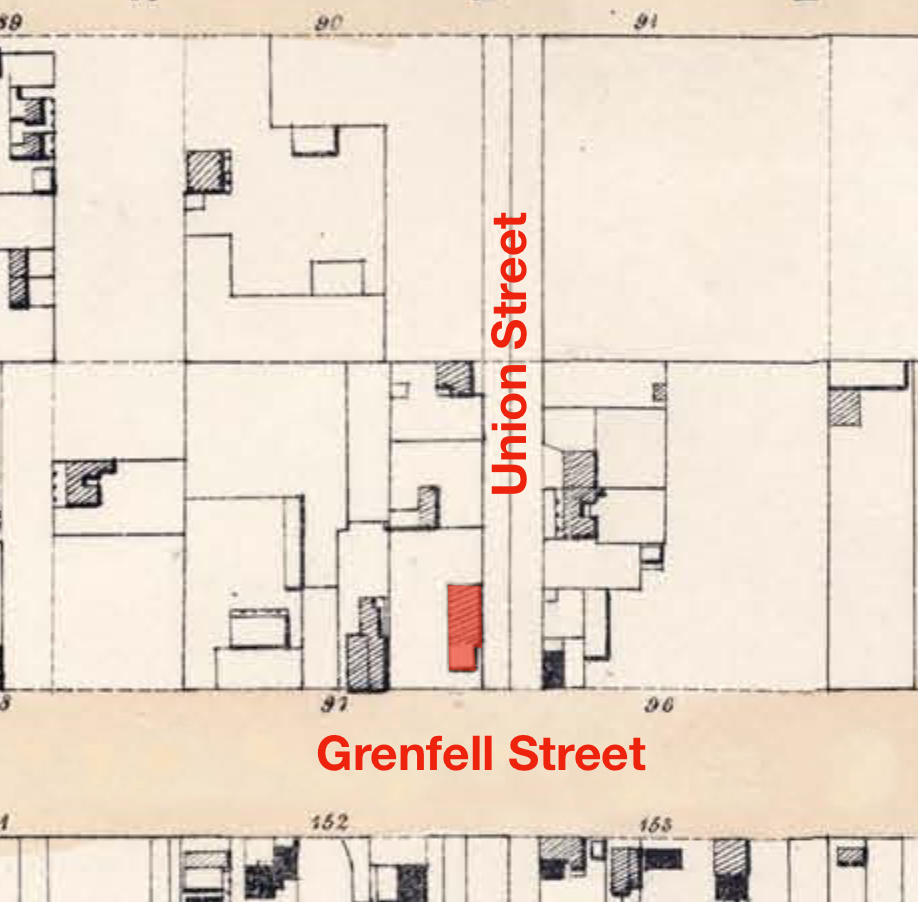
|
From about this time Wakeham was beset with financial problems forcing him to sell not only his "stock in trade as a builder and victualler" [South Australian, 22 June 1847, p.1; Adelaide Times, 5 March 1849, p.3; also South Australian, 24 July 1849, p.3] but also his interest in the hotel. In November 1847, Wakeham advertised, apparently without success, "to be let or sold, a freehold public house and land capable of further improvements and doing a lucrative trade" [South Australian Gazette and Mining Journal, 6 November 1847, p.1]; although not named, this could only have been the unfinished Union Inn.
Although the Magistrates renewed Wakeham's license for the Union Inn for 1848-49, it was apparent that he had been able to do little to improve the hotel over the past year [South Australian, 17 March 1848, p.2]. On 29 September 1848 Richard Bosworth, an investor, purchased the the property, including the "public house and other erections and buildings" at the same time effectively leasing the pub to William Clark, entrepreneur, and founder of the Halifax Brewery [LSG Memorial, 419/12]. Because Wakeham had "not kept his promise made long ago to increase the accomodations", in March 1850 the Bench of Magistrates refused to renew the Union's licence [South Australian, 15 March 1850, p.4]. However, at its next meeting, in June 1850, the Magistrates deemed that "the old house was [sufficiently] complete" [South Australian Gazette and Mining Journal, 13 June 1850, p.4]. For the next four or so years there followed a complicated series of changes of ownership, re-financing and leasing arrangements... and a succession of short-term licensees.
Three of these - John Fuller (1850), James Bryson or Bryceson (1851) and Thomas Melliar Phelps (1852) might well have been caretaker licensees, installed by Clark to manage the pub's "brisk outdoor trade" and to maintain the continuity of the license while the pub was being rebuilt. Although there is no direct evidence for this, it is also possible that Clark engaged William McLean, a carpenter/builder as well as an experienced publican, to complete and refurbish the pub. The Adelaide City Assessment Book for 1852 described the Union Inn as "10 rooms, stone and brick house, cellar and yard", with a rateable value of £80, "occupied" by McLean (not as would be expected by the licensee at the time, Bryson) and leased by W H Clark; at this stage the pub was a single-storied building, as recalled by an old time resident of Grenfell Street in 1919 [Register, 16 October 1919, p.5].
the Crown and Anchor on the SA History Hub (accessed May 22 2024) starts in the 1870s, after Ellery's trustees had sold the property.
Ellery's will specified that, on the death or remarriage of his wife, his entire real and personal estate, including the Crown and Anchor, be sold and the proceeds distributed amongst his beneficiaries [SRSA: GRS/1334/00001/26 File 2192, Ellery James, probate files... November 1871; The Express and Telegraph, 24 October 1873, p.2]. Consequently, on 8 May 1873 Ellery's executors auctioned "the well-known hotel, Crown and Anchor, consisting of 14 rooms, detached outbuildings, stabling, &c., at present let at £2 10s per week to a monthly tenant" and four of Ellery's neighbouring properties [South Australian Register, 26 April 1873, p.8]. For the Crown and Anchor, "there was a very brisk competition. The bidding started at £900 and the hotel was knocked down at [£1,400]" [Evening Journal, 8 May 1873, p.2]. In December 1872 the value of the pub was rated at £105 [ACC, Assessment Book 1873]!
|
The successful purchaser was Edwin Thomas Smith, [LSG Certificate of Title 181/34, 29 August 1873] "brewer" of the [Old] Kent Town Brewery as well as Mayor of Kensington and Norwood as well as member of the House of Assembly for East Torrens, later Mayor of the City of Adelaide, a founder of the South Australian Brewing Company and philanthropist. Interestingly, Ellery's other nearby properties were bought by current or future partners or close associates of Smith: J E Moulden, his solicitor, Thomas English, one of his architect and William Roussevell, his future partner and fellow politician [ACC, Assessment Book 1874].
How Smith financed such an acquisition - and why he seemingly paid over 13 times its rated value - is unclear. His son, Talbot Smith, later recalled that "he had an enviable faculty of making money. He would...buy a house with paddock and sell the house for the same price and retain the paddock" [Mail, 12 September 1942, p.12]. As the business manager and, from May 1866, the lessee of Edward Logue's (Old) Kent Town Brewery (he did not purchase the brewery itself until March 1877), and like many contemporary brewers, Smith understood the value of the vertical integration of breweries and pubs; in the 1860s, as proprietor of the (Old) Kent Town Brewery, Smith leased and/or subleased a number of metropolitan pubs, amongst them the Lady Gowrie and the Duke of Wellington in Port Adelaide, the Huntsman in North Adelaide and the Duke of Wellington in Adelaide [Historic name search in LSG's SAILIS]. The acquisition of the Crown and Anchor could well have been a strategic purchase in order to compete with other breweries that also controlled pubs in the area. Pubs that offered clean and comfortable accommodation, stabling and refreshment especially for travellers to the East End of Adelaide would have been attractive investments in the 1860s and 1870s. By the end of the 1860s well-formed and maintained roads and bridges across the East Parklands connected the East End to growing suburbs in the north and east and farms further afield while 'nuisance' industries such as Peacock's tannery had been forced to clean up or relocate. |
 |
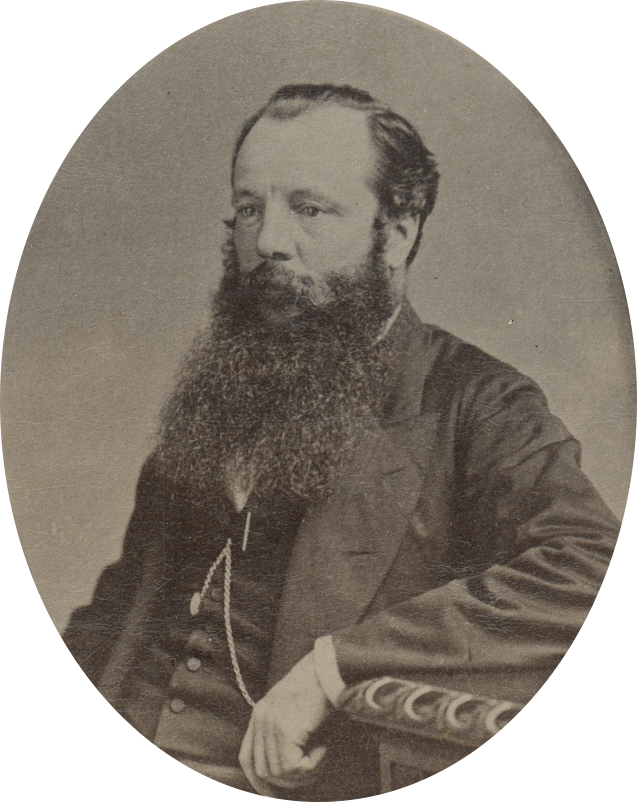
[SLSA B 1288-6] 
Certificates of title, 1873-1982 [LSG Certificates of Title] |
However, the major single factor was increased patronage resulting from the establishment of a major regulated fruit and vegetable exchange, the East End Market, between North and East Terraces and Rundle Street, in October 1872 and its gradual expansion over the next thirty years. To a large extent, the proliferation of new or rebuilt pubs in the East End aligned with the development of the market from the late 1860s to the first decade of the twentieth century. New pubs in the East End included the East End Market Hotel (1868), the Botanic [Family] Hotel (1877) and the Austral [Family] Hotel (1880); most existing pubs were substantially upgraded or completely rebuilt including the Tavistock (1884), the Exeter (1888), the Stag (1903) and the Woodman/Producers (1906) and the Crown and Anchor. [For more on these and other East End pubs, see the EastEnd Historic Pub-crawl.]
In March 1879 the Inspector of Licensing reported that the Crown and Anchor was one of several "houses [with] insufficient or poor accommodation and...also little or much out of repair" and that it had "bugs in all bedrooms" [Evening Journal, 14 March 1879, p.3; Express and Telegraph, 13 March 1879, p.3]. On 29 March Smith remortgaged the property presumably to at least partially finance its rebuilding [LSG Certificate of Title 181/34, 29 August 1873] and in August Thomas English, the architect of Smith's recently completed (New) Kent Town Brewery, invited tenders from builders for "rebuilding the Crown and Anchor Hotel, Grenfell Street" [South Australian Register, 13 August 1879, p.2]. Completed by the end of 1879, the Crown and Anchor was described as "a new two-story building...erected in lieu of the old single-story place. Mr English was the architect; cost about £1534". Important for over-nighting market gardeners, in March 1880 English and Soward tendered for the erection of stabling at the Crown and Anchor [South Australian Register, 10 March 1880, p.2]; in July stabling at the Crown and Anchor was offered for let, "new and commodious, numbering twenty-seven stalls. Two entrances, one off Grenfell Street and one from Union Street" [Express and Telegraph, 10 July 1880, p.1]. Although there have been periodic internal changes to the pub and the addition of verandahs and some external modernisation in 1928 [Register, 4 October 1928, p.5], the current Crown and Anchor occupies more or less the same footprint and and has more or less the same external structure as in 1880.
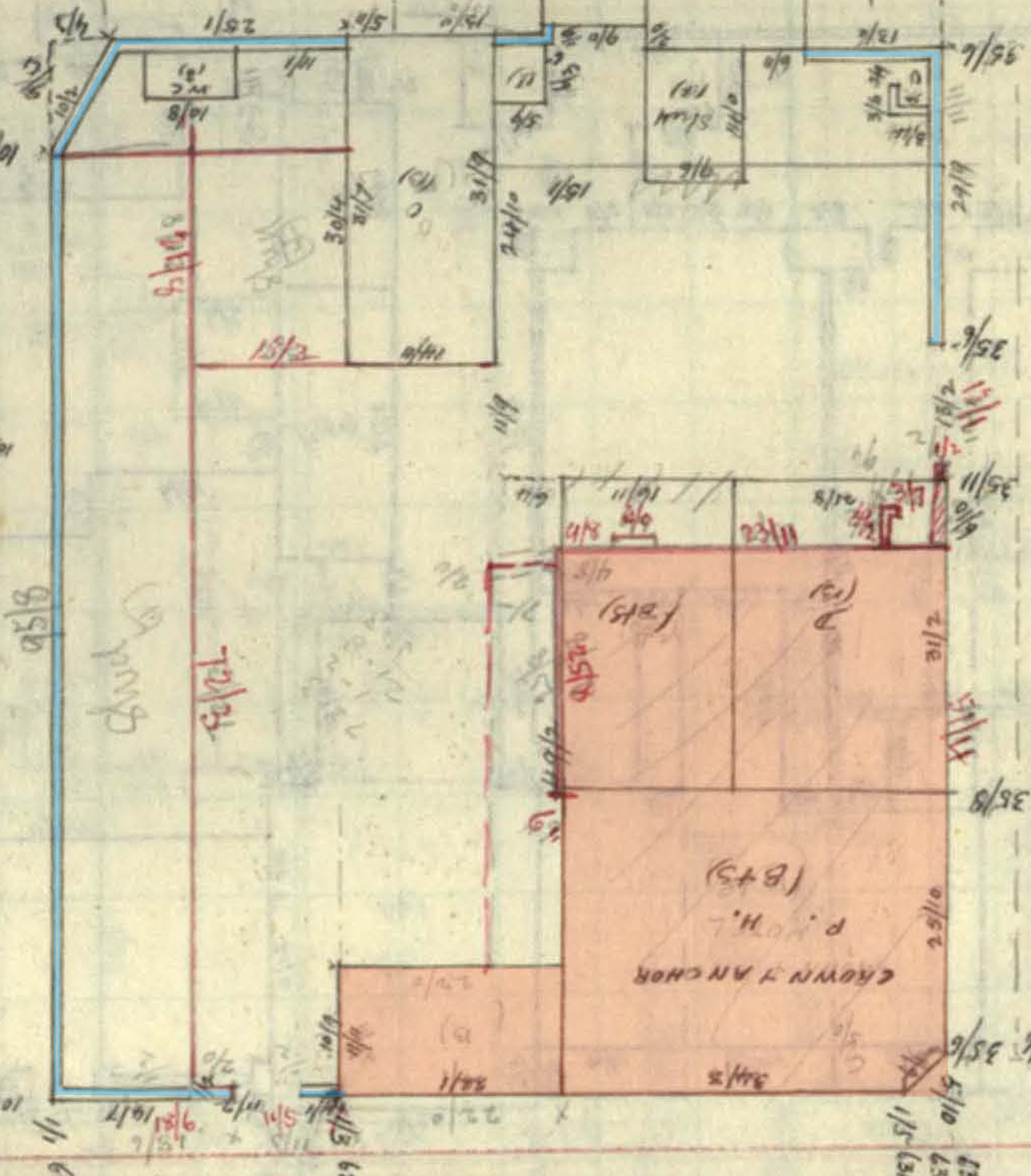
Plan of property of Crown and Anchor showing external walls, pub highlighed, 1880 [ACC [Smith's] Adelaide City Survey, Field Book, No.2, 1880] |
 |
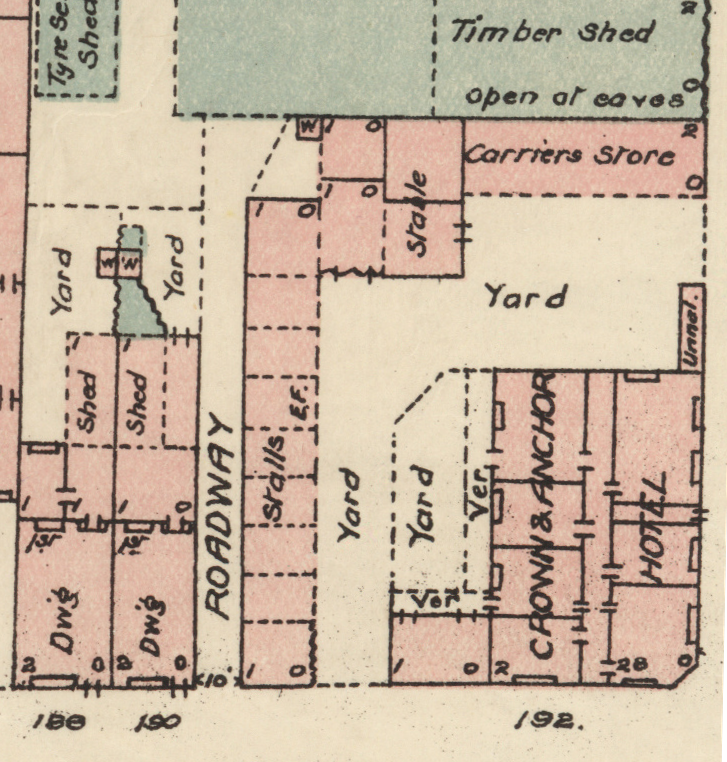
Detail of Garrett's plan of the property showing stables and storage area and the internal layout of the ground floor of the pub, 1924 [SLSA Map prepared for the Fire Underwriters Association...July 1924] |
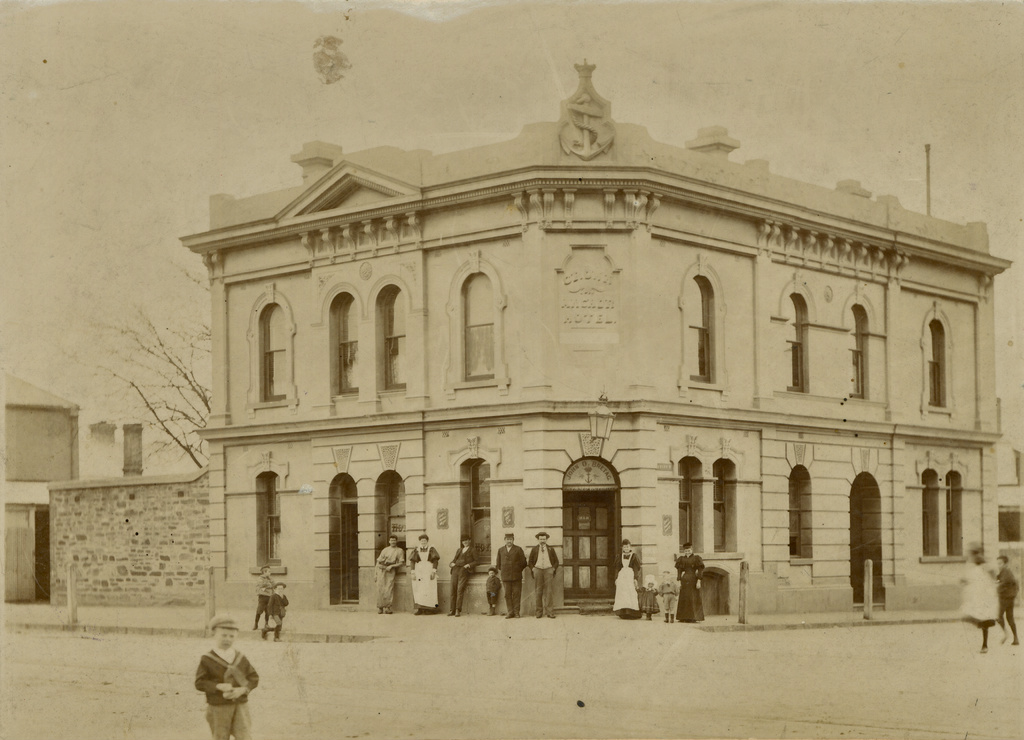
The Crown and Anchor in 1896 [SLSA B-9027] |
 |
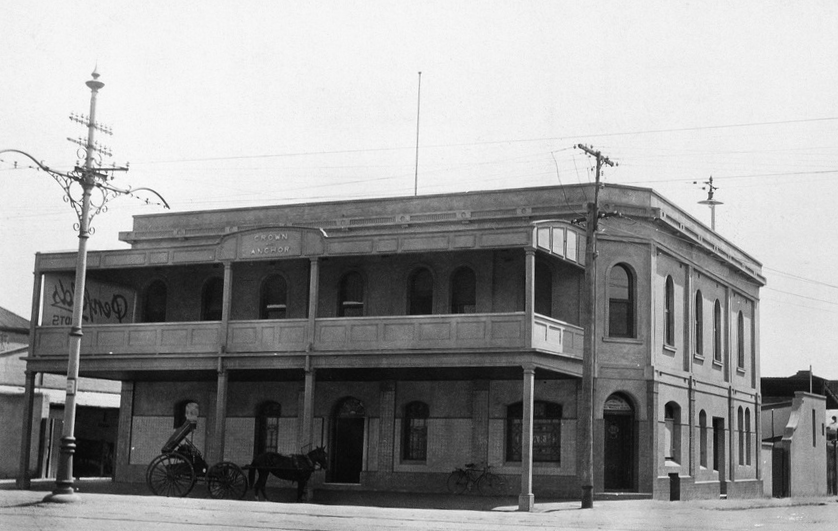
...and in about 1930 [SLSA B-5731] |
For most of its 175 or more years, the pub's 'community' was the growers and greengtocers trading at the 'unofficial' wholesale fruit and vegetable market operating behind the Stag Hotel as early as 1854 and then the regulated markets established by Richard Vaughan and William Charlick from the 1870s to the 1910s and which survived until the residential development in the 1990s. (On the markets, refer to Alexander Parson's short history of the East End Markets; also see Bill Chartre's East End Markets site for an insider's history of the markets.)

The east end of Grenfell Street, 1911. The Crown and Anchor is at the far left. [SLSA B 8527]
New-ish Historic Pub-crawls
These and other self-guided Historic Pub-crawls are downloadable freely for non-commercial use. Enjoy the walks but, above all, go into one or more of the pubs for a responsible drink or two and maybe a meal.
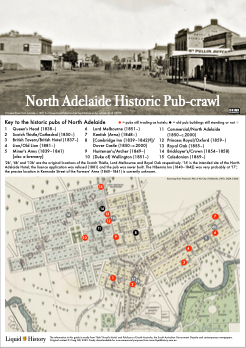
North Adelaide Historic Pub-crawl map/guide |
 |
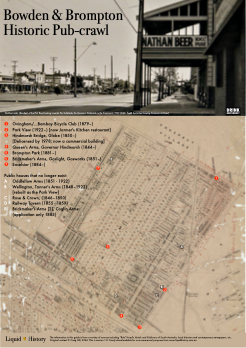
Bowden and Brompton Historic Pub-crawl map/guide |
 |
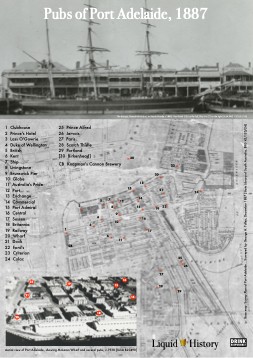
Port Adelaide Historic Pubs (map) |
Posted 27 May 2024 Original content © Craig Hill 2024

